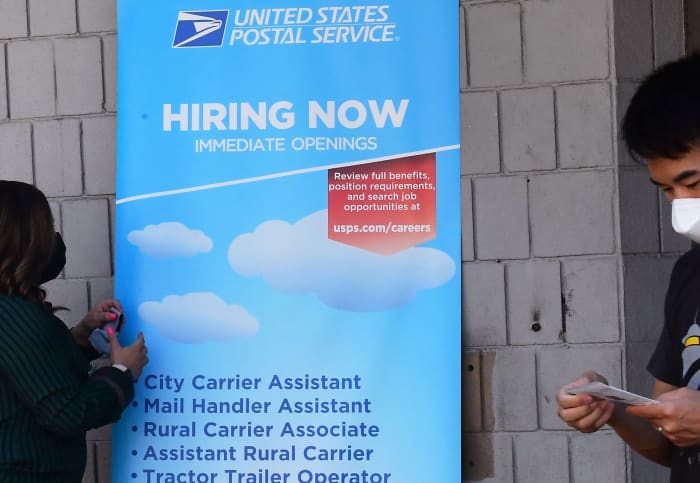#Market Extra: U.S. jobs data triggers debate by investors over whether the labor market has suffered permanent pandemic-linked scarring

Table of Contents
“#Market Extra: U.S. jobs data triggers debate by investors over whether the labor market has suffered permanent pandemic-linked scarring”

Frederic J. Brown/Agence France-Presse/Getty Images
September’s nonfarm payrolls report is raising questions in some investors’ minds over whether the U.S. labor market has suffered permanent pandemic-linked scarring that could keep inflation persistently higher, potentially forcing market participants and policy makers to readjust their expectations.
The so-called labor-force participation rate, or the portion of working-age people who have a job or are looking for one, was little changed at 61.6% last month — suggesting millions of Americans still remain sidelined. The rate has stayed within a narrow range since June of last year despite the reopening economy, and is 1.7 percentage points lower than where it was in February 2020 as the pandemic took hold in the U.S.
That matters because unemployment benefits for millions of Americans ended last month, an event that still wasn’t enough to bring many people back into the labor force. Meanwhile, average hourly earnings rose during September as businesses struggled to lure folks from the sidelines. Rising wages are one reason that inflation could stay elevated for longer, while forcing financial markets and policy makers to rethink their economic outlooks and expectations about policy rates, investors say.
“Without a doubt, the labor markets have been scarred, but the level of the permanent scarring has yet to be seen,” said Matt Peden, director of investments for American Beacon Advisors in Irving, Texas. “On average, labor represents a large portion of a company’s total costs structure, so the increase in wages will most likely be passed on to the consumer to maintain margins — which is inflationary.”
“The Federal Reserve will have to monitor the situation closely as wage inflation tends to be more permanent than transitory,” Peden, whose firm managed $75.2 billion in assets as of June, wrote in an email to MarketWatch. “Depending on the level of wage inflation, it could put more pressure on their `lower-for-longer’ strategy” on interest rates.
Financial markets struggled to interpret Friday’s jobs report, which reflected a much weaker-than-expected 194,000 new jobs created, but saw the jobless rate drop to 4.8% and upward payroll revisions to prior months that gave investors at least some hope. Soon after the September’s nonfarm payrolls report was released early Friday, markets whipsawed, with U.S. stock indexes, bond futures, and the U.S. Dollar Index
DXY,
all bouncing around in choppy trade.
Read: Dow wobbles as jobs report shows gain of 194,000 in September as people drop out of labor force
“The market and the Fed are adjusting to a higher normal on inflation and a labor force that’s struggling to find its footing from here,” Rob Daly, director of fixed-income at Glenmede Investment Management, said via phone. “I don’t think we have a guide post from the past as to how this is going to resolve itself in the present, but these structural changes are going to last for longer, absolutely.”
“While the headline jobs number didn’t look great, the revisions were quite good,” said Daly, who oversees $4.5 billion from Philadelphia. Still, “there are some structural changes afoot, and it’s going to take longer to get people back into the labor force.”
Major stock averages ended slightly lower, with the Dow Jones Industrial Average
DJIA,
falling less than 0.1%, the S&P 500 index
SPX,
shedding 0.2%, and the Nasdaq Composite Index
COMP,
lower by 0.5%. The dollar index down by 0.1%, while Treasury yields were higher.
Glenmede’s Daly says part of the reason for the rise in the 10-year Treasury rate
TMUBMUSD10Y,
above 1.6% on Friday, along with the steepening of the spread between 2- and 10-year rates, was due to investors pricing in “a more durable inflation impulse into bond yields.”
In a note released just before the jobs report on Friday, Vicky Redwood, a senior economic adviser for London-based Capital Economics, said that in the year since the pandemic began, “the most immediate question has been about the permanent scarring to the economy.”
“The one way in which we were too optimistic, at least in the U.S., was in expecting the labor supply to emerge unscathed,” she wrote. “ Although much of the decline in the labor force looks due to temporary factors (for example, because of virus fears), some reflects an increase in early retirees who are unlikely be tempted back to work.”
By
Vivien Lou Chen
If you liked the article, do not forget to share it with your friends. Follow us on Google News too, click on the star and choose us from your favorites.
For forums sites go to Forum.BuradaBiliyorum.Com
If you want to read more News articles, you can visit our News category.




